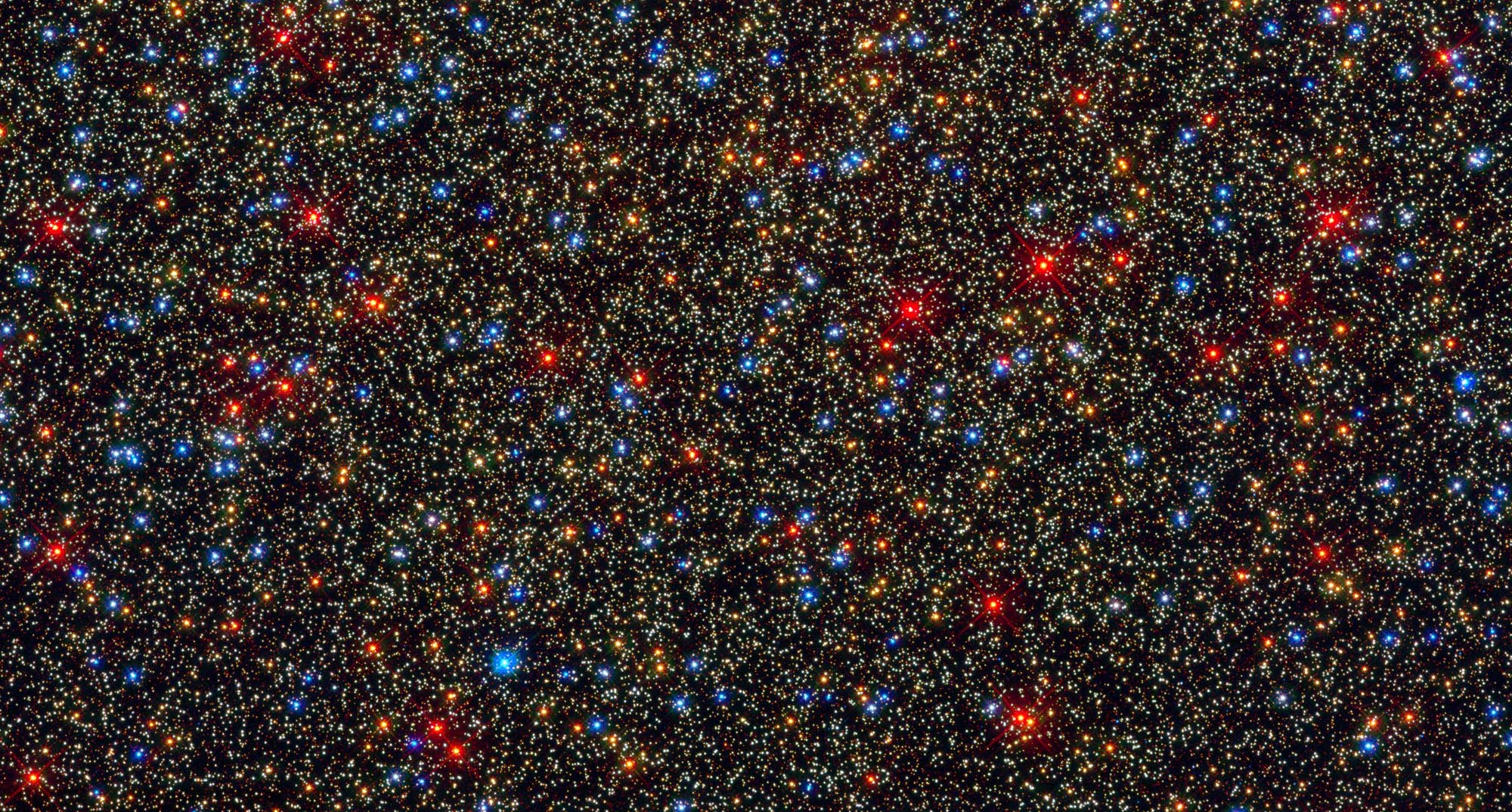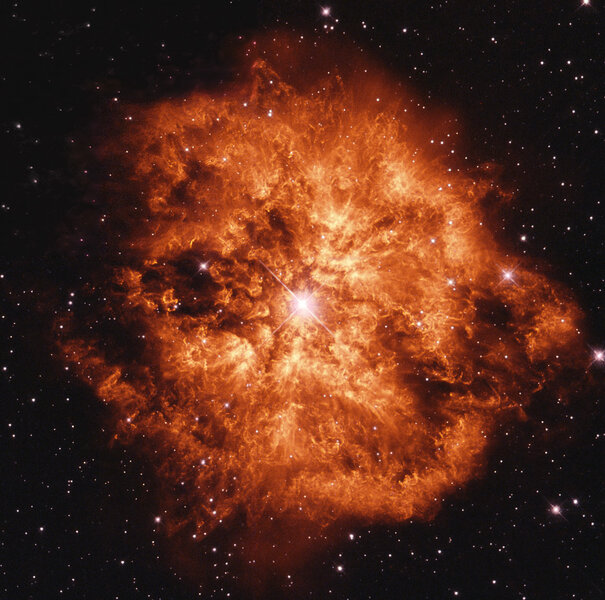Measuring all the light in the Universe. All of it. Ever.

Here’s a question you’ve probably never asked yourself: What is the total number of photons (particles of light) that have been produced in the Universe, ever, from the Big Bang to today?
And yes, duh, of course I’ve asked that question to myself before, mostly in an effort to come up with the biggest practical number I could think of (that is, a number with some physical meaning, a number you could use to actually count something up), but also because I’m a huge dork.
It’s an interesting question. Not necessarily because of the number itself, but also because of what you need to know to figure it out… namely, the star formation rate since the Universe began. Literally, not just how many stars have been born, but at what rate they form, and also how that rate may have changed over time.
A new study has come out that does this… sorta. The scientists involved were actually interested in the star formation rate and how it’s changed over time, because that tells you a lot about the Universe itself, including how galaxies form, how conditions in the Universe have changed since the Big Bang, and more. But you can get the number of photons from that, and while they don’t actually calculate it in the paper, they did for the press release.
And the total number of photons that have ever existed is a big number. A very big number.
Are you ready? It’s:
4,000,000,000,000,000,000,000,000,000,000,000,000,000,000,
000,000,000,000,000,000,000,000,000,000,000,000,000,000
!!!
That’s 4 x 1084, a mind-vaporizingly colossal number. That’s 4 trillion trillion trillion trillion trillion trillion trillion, or, if you prefer, 4 sextillion vigintillion. It’s so big it’s hard to compare to anything else.
Like, there have been roughly 4 x 1026 nanoseconds elapsed since the Universe began, and this number crushes that one into dust. It’s 1058 times bigger!
It’s actually very very roughly the same as the number of subatomic particles of matter in the Universe, if that helps any.
It doesn’t help me any. It’s too big.
[Addendum (Nov. 30, 2018): A few folks on Twitter pointed out that when the Universe was very young, just 400,000 years old or so, it was as hot as a star and there were a lot of visible light photons flying around. Today that that light makes up the cosmic microwave background (CMB), but back then it was visible light, and may have added up to 1089 photons! So, a lot more. My mistake: The photons counted up here only go back 11.6 billion years, as I explain below, so the CMB was excluded. My apologies for not being clear on that! If I had thought of the CMB in the first place I would've talked a bit about that!]
You know what? I’ll come back to that number. Instead, let’s talk about stars for a minute.
In astronomy, stars are pretty much the basic unit. They make up galaxies, and galaxies make up galaxy clusters, and those make up superclusters, the largest structures in the cosmos. But it starts with stars (and dark matter, but that’s much harder to figure out, so let’s stick with stars for this purpose).
Stars are born in gas clouds called nebulae. In general, massive stars are much more rare than low-mass stars. For every hefty, blue, luminous star there might be 10 like the Sun, and a thousand dim red dwarfs. Astronomers call this distribution the stellar mass function, and it’s important because it tells you a lot about how stars are made. In some galaxies it’s different than in others, depending on a lot of different circumstances. It can even be different in different parts of a single galaxy, too. When the Universe was young it was different as well.
The rate at which stars are born changes too. Some galaxies are fecund, like our own home galaxy, the Milky Way. On average it produces about one Sun’s mass worth of stars per year, more or less*. In some galaxies that rate is much, much lower. Star formation may have done well back in the day a few billion years back, but if the galaxy ran out of gas to make them, then nowadays things have slowed way down.
So by measuring the star formation rate in different galaxies we can learn a lot about them. And if we look really far away, across the Universe, we see galaxies as they were when they were young, too, so we can measure how that’s changed over time as well.
There are different ways to do that, most of which involve looking at massive stars. These are brightest, and easiest to see a long way off. They also produce a type of ultraviolet light that makes it easier to figure out the star formation rate.
But this method has lots of problems. That light can be obscured by dust clouds. You need huge surveys looking at lots and lots of galaxies to get decent numbers. And also, because massive stars sit at the top of the mass function, it’s a little dicey to use them to figure out how many dinkier stars there are. Massive stars are rare, so if you miss a few you really mess up how many lower mass stars there are.
Worse, a lot of stars formed early on in the Universe in galaxies that are so faint they’re invisible to us now. Heck, small galaxies are hard to see when they’re nearby, let alone a billion (or 10!) light years away.
What’s needed is a different way to do this that doesn’t rely on adding up starlight. So a team of astronomers came up with a novel way to do this that doesn’t suffer from all those problems I mentioned.
Instead of looking at visible light, they look at gamma rays, which are an extremely high energy form of light, and can be detected from very far away. They can be made in lots of different ways, including when black holes gobble down matter, a very common event in the early Universe.
The key to this is a weird thing that happens to gamma rays above a certain energy: If they collide with a random lower energy photon minding its own business as it travels across the Universe, the collision can convert the gamma ray into matter (see “mc2, E=”). This produces a pair of particles, an electron and its antimatter equivalent, a positron, so we call this “pair production.”
The gamma ray has to have enough energy to do this, so when we look at one of these really bright galaxies, we should see fewer gamma rays from them at super high energies, because as those make their way to us they hit a photon and undergo pair production.
The more background photons there are, the more likely a collision will occur (just like you get wetter walking through a heavy rain than a light sprinkle), and the more attenuated these gamma rays get. So by measuring the gamma rays, the astronomers reasoned, they can actually measure how many background photons there are: The total number of photons in the Universe, and from that they can figure out the star formation rates at different ages in the cosmos.
Here's a synopsis of this in video form:
This is still really hard, and relies on lots of assumptions… but pretty good guesses at a lot of these uncertainties can be based on other observations. So the astronomers used the Fermi gamma-ray telescope orbiting the Earth, using 9 years of data to investigate the gamma rays from 739 high-energy galaxies (called blazars) at all different distances from us, from 200 million to 11.6 billion light years away. Using some statistical methods, they were then able to figure out how many gamma rays we should see, and how many we did see, and therefore figure out the density of background photons in the Universe.
And that’s where our Very Big Number came from: How many photons there are. How many there have ever been [addendum: at least, going back 11.6 billion years.]
But they also figured out how things have changed over billions of years in the Universe, which was their actual goal. Happily, what they found is pretty consistent with earlier work; since this was done in a completely independent way it gives them confidence they have this at least close to right.
What they found is that right after the Universe began and it cooled off enough to form stars, not many were made. Then, over the next few billion years the rate increased until it peaked about 10 billion years ago, a few billion years after the Big Bang. It’s been dropping ever since.
Eventually it’ll drop to 0. It has to: At some point there won’t be enough available gas left in the Universe to make stars. When that happens no more will be born, and as stars run out of fuel the Universe will eventually grow darker... until the last star fades out, roughly a trillion or more years from now.
If you want details on that, feel free to read my book Death From the Skies! It’s… a little disturbing, but it’s not the obligation of the Universe to cheer us up. And hey, who knows, maybe someday we’ll find a way to reverse the process.
But for now, the Universe is filled with light. It looks dark because it’s big and expanding and not very old, but there a lot of photons zipping around out there.
4,000,000,000,000,000,000,000,000,000,000,000,000,000,000,
000,000,000,000,000,000,000,000,000,000,000,000,000,000 of them. Give or take.
And yeah, I’m still having trouble with this number. I’m not even sure what to do with it. Can you use it in everyday conversation? “I lost my keys, but at least they’re easier to find than the 4 x 1084 photons in the Universe!” Or, “OH MY GOD I’ve seen this same YouTube ad so many times it feels like 4 x 1084, the number of photons that have ever existed in the Universe!”
I actually have conversations like that.
Anyway, there you go. And even if all this is weird and freaky and making your brain hurt, the takeaway you can cherish — besides astronomers loving big numbers — is that sometimes asking really basic questions can lead to really profound conclusions. Asking how much light is out there tells you what the Universe was once like, what it’s like now, and what it will be like trillions of years hence.
Science is all about asking basic questions and finding answers when we can… and then being surprised at what other answers were just waiting to be found when the right question was asked.
* I don’t mean one star like the Sun is born every year. For one thing it’s more of an average over a long time (stars take a while to get going). Also, that mass is distributed over lots of different kinds of stars. So if you look at, say, a few thousand years, you might get a dozen new massive stars, a couple of hundred like the Sun, and a few thousand with half the Sun’s mass.




























